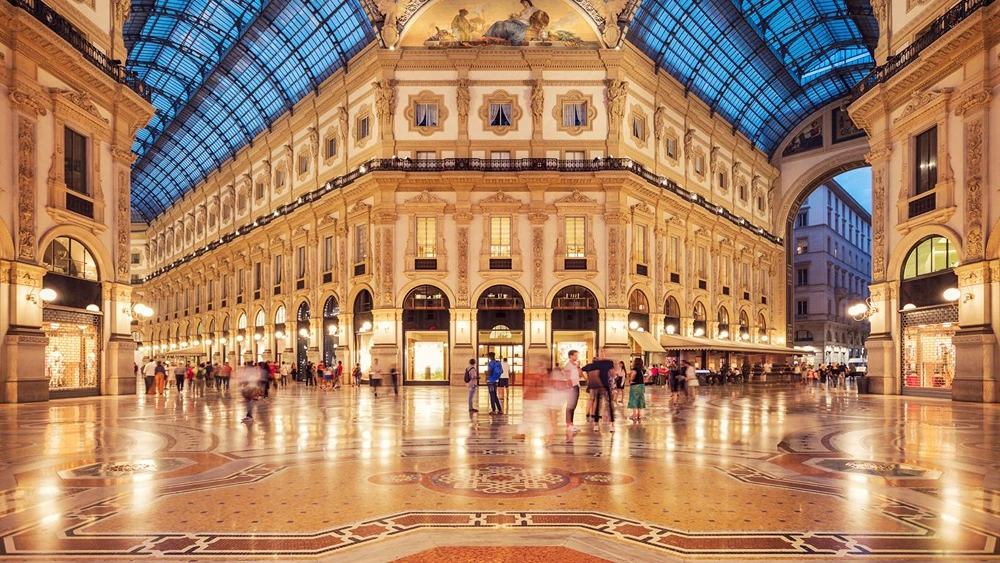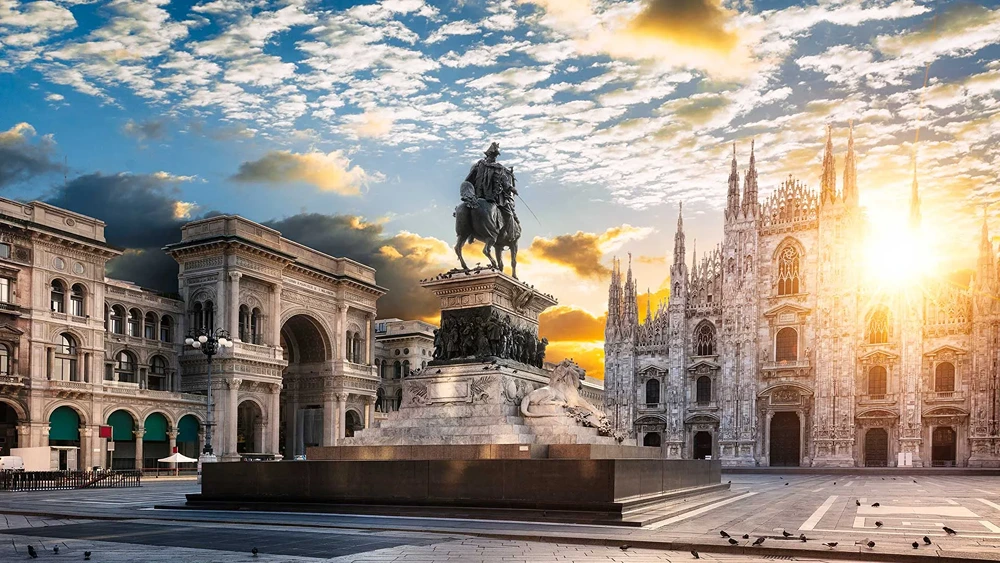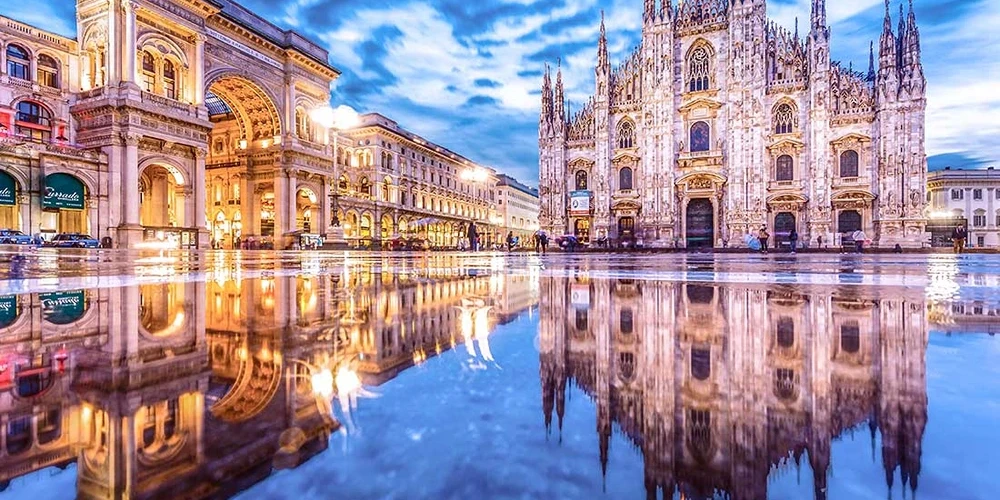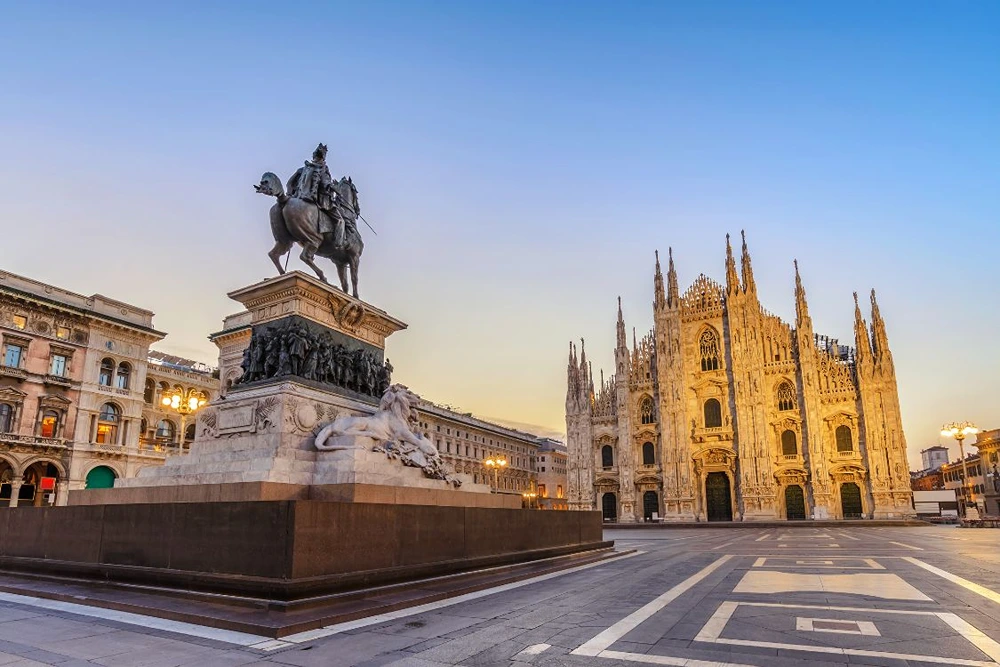Travel Resources
Before you embark on your Milanese adventure, consider these valuable resources:
- Flights: Find affordable options to Milan using our flight search tool.
- Travel Insurance: Ensure peace of mind with comprehensive coverage for your trip.
- Car Rental: Explore Milan and the Lombardy region at your own pace.
- Tours: Discover the best experiences with trusted local operators.
Packing Checklist: Don’t forget essentials like comfortable shoes and a travel adapter.

Some History First
Milan’s history is a tapestry of power, culture, and innovation. Founded by the Celts around 600 BCE, Milan became part of the Roman Empire in 222 BCE and later served as the capital of the Western Roman Empire. The city reached its golden age during the Renaissance under the powerful Visconti and Sforza families, becoming a center of art, science, and commerce. Milan was the birthplace of iconic figures like Leonardo da Vinci and Alessandro Manzoni, who shaped Western art and literature. The city played a crucial role in Italy’s unification in the 19th century and emerged as a major industrial hub. Milan’s rich history is evident in its architecture, from Roman ruins to Gothic cathedrals and Renaissance palaces, making it a living testament to centuries of Italian history and culture.
Milan Today
Today, Milan stands as Italy’s economic powerhouse and a global fashion and design capital. With a population of about 1.4 million, Milan is the second-most populous city in Italy and the heart of the country’s most prosperous metropolitan area. The city hosts world-renowned events like Milan Fashion Week and the Salone del Mobile, cementing its status as a trendsetter in style and design. While preserving its historical heritage, Milan embraces modernity with cutting-edge architecture, a thriving startup ecosystem, and a vibrant cultural scene. The city continues to be a hub for art and culture, hosting numerous exhibitions and events throughout the year. Milan’s blend of business acumen, creativity, and dolce vita lifestyle makes it a dynamic destination that appeals to both history enthusiasts and contemporary trendsetters alike.
Is Milan Safe?
Milan is generally considered a safe city for tourists and residents. The city has a moderate crime rate compared to other major European tourist destinations. However, as with any popular tourist spot, it’s important to stay vigilant. Be aware of pickpocketing in crowded areas, especially around major attractions like the Duomo and Central Station. It’s advisable to take standard precautions such as keeping valuables secure and being aware of your surroundings. The city center is well-lit and patrolled, making it safe to explore even in the evening. Milan’s efficient public transportation system is generally safe, but exercise caution during late hours.
Where is Milan?
Milan is strategically located in northern Italy, serving as the capital of the Lombardy region. The city lies in the western part of the Po Valley, surrounded by the Alps to the north and the Apennine Mountains to the south. Milan is approximately 50 km (31 miles) from the Swiss border, making it a gateway to both central Europe and the Mediterranean. It’s about 570 km (354 miles) northwest of Rome and 280 km (174 miles) east of Turin. This prime location has contributed to Milan’s historical importance as a center of trade and its modern role as a major transportation hub, with excellent connections to other Italian and European cities.
Latest Articles
From The Area
What is the Best Time to Visit Milan?
Milan can be enjoyed year-round, but certain seasons offer distinct advantages:
- Spring (March to May): Ideal weather for sightseeing with mild temperatures. The famous Salone del Mobile furniture fair takes place in April.
- Fall (September to November): Pleasant weather and exciting events like Milan Fashion Week in September. Perfect for enjoying seasonal cuisine and wines.
- Summer (June to August): Hot and humid, with many locals leaving for vacation. However, it’s great for enjoying outdoor cafes and summer festivals.
- Winter (December to February): Cooler temperatures and occasional fog, but magical Christmas markets and winter sales in January attract visitors.
How to Get to Milan & Around
Milan is well-connected and easily accessible:
- By Air: Milan is served by three airports: Malpensa (MXP) for international flights, Linate (LIN) for domestic and short-haul European flights, and Bergamo (BGY) for budget airlines.
- By Train: High-speed trains connect Milan to major Italian and European cities, arriving at Milano Centrale station.
- By Bus: Long-distance buses offer budget-friendly options from various Italian and European cities.
Getting around Milan:
- Metro: Efficient subway system with four lines covering most of the city.
- Trams and Buses: Extensive network complementing the metro system.
- Walking: The historic center is compact and pedestrian-friendly, making walking the best way to explore the main attractions.
- Bicycles: Bike-sharing services like BikeMi are popular for exploring the city and nearby areas.
Things to Do in Milan
Milan offers an incredible array of attractions and activities:
- Duomo di Milano: The iconic Gothic cathedral, climb to the rooftop for panoramic city views.
- Leonardo da Vinci’s Last Supper: Book well in advance to see this masterpiece at Santa Maria delle Grazie.
- Galleria Vittorio Emanuele II: Historic shopping arcade with luxury boutiques and cafes.
- Sforza Castle: 15th-century fortress housing several museums and art collections.
- Pinacoteca di Brera: Premier art gallery with works by Italian masters.
- Navigli District: Charming canal area known for its vibrant nightlife and aperitivo scene.
- Teatro alla Scala: World-renowned opera house, take a tour or attend a performance.
Quadrilatero della Moda: Milan’s famous fashion district for high-end shopping.
Where To Stay In Milan
Milan offers a wide range of accommodation options:
- Duomo Area: Central location with easy access to main attractions, but can be crowded and expensive.
- Brera: Artistic neighborhood with charming streets, galleries, and boutique hotels.
- Navigli: Lively area along the canals, popular with younger travelers for its nightlife.
- Porta Nuova: Modern district with skyscrapers and contemporary hotels.
- Città Studi: University area with more affordable options, well-connected by public transport.
Book well in advance, especially during Fashion Week, Design Week, and other major events.

What To Eat In Milan
Milanese cuisine is a highlight of any visit:
- Risotto alla Milanese: Saffron-flavored risotto, a local specialty.
- Cotoletta alla Milanese: Breaded veal cutlet, similar to Wiener Schnitzel.
- Osso Buco: Braised veal shanks, often served with risotto.
- Panettone: Traditional Christmas cake originating from Milan.
- Aperitivo: Pre-dinner drinks accompanied by small bites, a Milanese tradition.
- Gorgonzola: Creamy blue cheese from the nearby town of Gorgonzola.
- Espresso and Pastries: Start your day like a local with a quick espresso and sweet pastry at a café.
Don’t miss the chance to explore the Mercato Metropolitano or Eataly for a wide range of local and Italian specialties.
Entry & Exit Requirements
As part of Italy and the Schengen Area, Milan follows common EU border policies:
- EU citizens: Can enter with a valid ID card or passport.
- Non-EU citizens: Generally need a valid passport and may require a Schengen visa. Check specific requirements based on your nationality.
- Stays longer than 90 days: May require a long-stay visa or residence permit.
Always check the latest entry requirements before your trip, as they can change.
What To Pack For Your Trip
Consider these essentials when packing for Milan:
- Comfortable walking shoes for exploring the city’s streets and extensive metro system
- Smart-casual clothing for dining out and visiting high-end establishments
- Travel adapter for European outlets
- Reusable water bottle to stay hydrated
- Italian phrasebook or language app
- Light jacket or sweater, even in summer, for air-conditioned spaces
- Umbrella or rain jacket, especially in spring and fall
- Fashionable attire if you plan to indulge in Milan’s nightlife or high-end shopping
Remember to pack any necessary medications and a copy of your travel insurance.
FAQs
The official currency of Italy is the Euro (EUR).
While Italian is the official language, many locals in tourist areas speak English. Learning basic Italian phrases can enhance your experience.
Yes, major credit cards are widely accepted in most establishments in Milan.
Explore nearby destinations such as Lake Como, Bergamo, and Verona for a memorable day trip from Milan.



